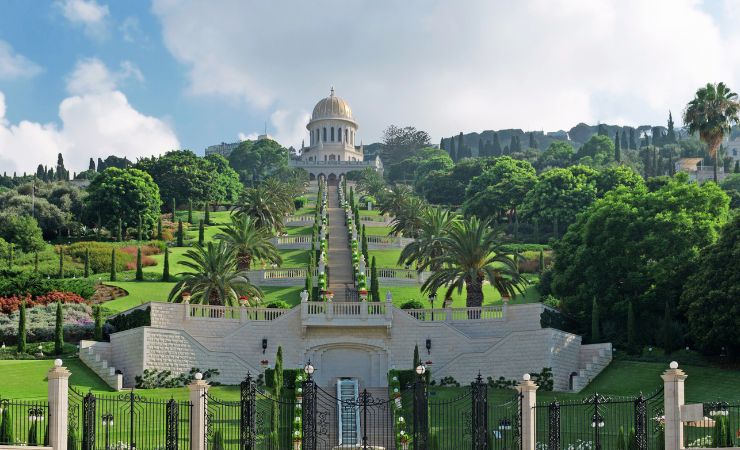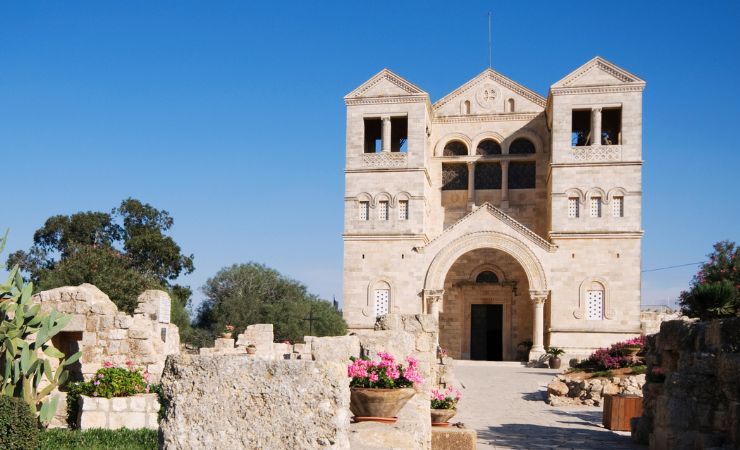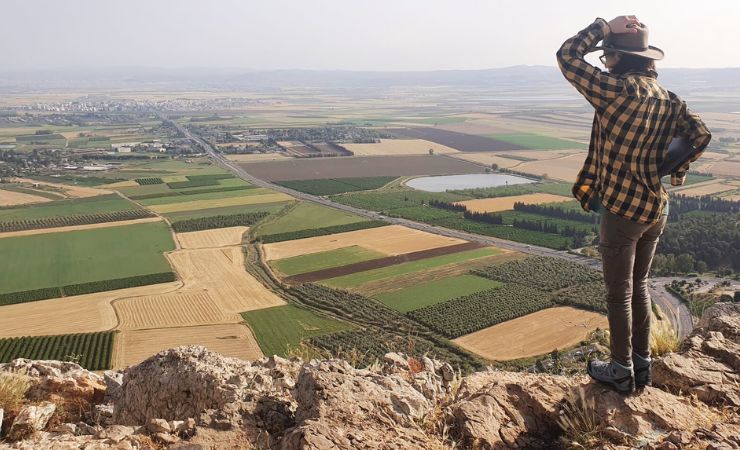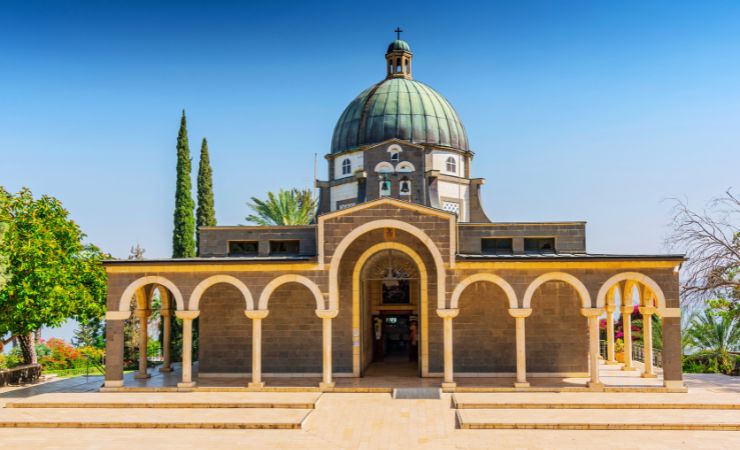The Baháʼí Gardens: A UNESCO World Heritage Experience
The Bahá’í Gardens house the Bahá’í World Centre and are recognized for its “outstanding universal value” by UNESCO. These sites were added to the World Heritage List in 2008, signifying their importance for preservation for future generations.

Location
In Haifa, the Baháí Gardens are located on the northern slope of Mount Carmel stretch for about one kilometer in length. Designed as a series of nineteen terraces, they create a striking stepped landscape that stretches from the base of the mountain to its summit.
The Baháʼí Religion
The Bahá’í Faith is a relatively young monotheistic religion that was founded in the 19th century and today has more than five million followers in over 200 countries and territories. It originated in Iran, where its early leaders and followers faced severe persecution. Although the Bahá’í Faith began in a Muslim cultural context, it has grown into a global religion with its own identity, drawing architectural and cultural inspiration from both Eastern and Western traditions.
The first major figure in the Bahá’í Faith was the Báb, regarded as a prophet who prepared the way for a greater religious messenger. His growing number of followers drew the attention of the authorities, and thousands were tortured or killed. The Báb himself was imprisoned for three years and then executed in 1850 in Tabriz, Iran. His remains were secretly moved out of Iran and hidden for fifty years before being brought to the Holy Land. Today, his final resting place is the Shrine of the Báb on Mount Carmel in Haifa.
The founder of the Bahá’í Faith, Baháʼu’lláh, was exiled from Iran in 1854 and eventually imprisoned in the fortress city of Acre (Akko) by the Ottoman Empire. He lived the rest of his life in the area, which became a center for the growing Bahá’í community. Before his death, Baháʼu’lláh designated Mount Carmel as the location for the Bahá’í administrative center and instructed that the remains of the Báb be buried there. His own burial place is in Bahjí, near Akko, in a site that is considered the holiest location for Bahá’ís.
Core Values and Beliefs
The Bahá’í Faith is built on values of unity, peace, and spiritual harmony. Central to its teachings is the belief in the oneness of all humanity and the importance of setting aside prejudice of any kind—whether based on race, nationality, or religion. The religion promotes the idea of a balanced and just society, where cooperation replaces conflict. These core principles are reflected not only in the writings of the Bahá’í Faith but also in the carefully planned design of its gardens, which aim to express beauty, order, and serenity.
The faith envisions a future of global peace and mutual understanding between cultures and civilizations. Its teachings seek to bridge the divide between East and West, and this symbolic unity is mirrored in the layout and architecture of Baháʼí sites.



Symbolism in the Baháʼí Religion
Symbolism plays an important role in the Bahá’í Faith, and many of its sacred numbers and shapes are reflected in its architecture and garden design. One of the most prominent examples is the number 19, which appears in both the Bahá’í calendar—consisting of 19 months of 19 days each—and in the structure of the terraced gardens in Haifa, which are arranged across 19 levels. This number carries spiritual meaning and is closely associated with themes of unity and order.
The faith also uses specific symbols to represent its teachings. The five-pointed star is the official symbol of the Bahá’í Faith, while the nine-pointed star is widely recognized as a symbol of completeness and unity. The number nine, which is the highest single-digit number, is often used in Bahá’í design and iconography to represent the coming together of different religious traditions into a single, universal faith. These symbols appear subtly throughout the Bahá’í gardens and buildings, adding another layer of meaning for those who visit.
The Baháʼí Gardens
Why Haifa?
Haifa holds a special place in the Baháʼí Faith, largely due to historical events and instructions given by its founders. Baháʼu’lláh, the Prophet-Founder of the religion, directed that the remains of the Báb be brought to Mount Carmel in Haifa for burial. He also instructed that the administrative headquarters of the Baháʼí community be built near this sacred site. These decisions established Haifa—along with nearby Akko—as one of the two holiest cities for Baháʼís around the world.
Today, Haifa is home to the Baháʼí World Centre, where much of the international coordination and leadership of the religion takes place. This includes the study and translation of sacred texts and decisions that guide the worldwide Baháʼí community. The Universal House of Justice, the highest governing institution of the Baháʼí Faith, is also located here.
The Gardens
The Baháʼí Gardens in Haifa are carefully designed and maintained, reflecting a philosophy of order, harmony, and respect for nature. They are intended to convey spiritual meaning through their symmetry, structure, and integration with nature and reflect the relationship between the divine and creation.
Planning for the terraced gardens began in the 1980s and involved collaboration with environmental experts to ensure ecological responsibility. Water conservation has been a long-standing priority, with sustainable practices such as mulching and the use of drought-resistant plants in place since the 1950s. The layout follows a hierarchical approach: the central terraces feature vibrant, seasonally planted flower beds and decorative areas like cactus gardens, while the surrounding zones are planted with low-maintenance native species including rosemary, oleander, yucca, almond, and olive trees. These outer areas support local biodiversity and help preserve the natural balance of the site.
Main Monuments and Features
The Shrine of the Báb
At the heart of the Baháʼí Gardens in Haifa stands the Shrine of the Báb, a prominent landmark crowned with a golden dome. This shrine marks the resting place of the Báb, the Prophet-Herald of the Baháʼí Faith. Completed between 1948 and 1953, the structure was designed by Canadian architect William Sutherland Maxwell in collaboration with Shoghi Effendi, a key leader of the faith. The architecture combines elements from both Eastern and Western traditions—its dome represents unity, stained glass windows echo Christian cathedrals, minaret-like forms suggest Islamic heritage, and the colonnade reflects classical Roman and Greek styles. Together, these features represent the Baháʼí principle of the unity of civilizations.
The Shrine of Baháʼu’lláh
Located in Bahjí, near the city of Akko, the Shrine of Baháʼu’lláh holds the remains of the Prophet-Founder of the Baháʼí Faith. This site is the most sacred location in the world for Baháʼís and serves as a place of pilgrimage. Though more modest in appearance than its Haifa counterpart, the shrine and surrounding gardens offer a peaceful and spiritually significant experience.
The Arc Buildings
Higher up on Mount Carmel are the Arc Buildings, which house the international administrative institutions of the Baháʼí Faith. These include the Seat of the Universal House of Justice—the supreme governing body—the International Teaching Centre, the Centre for the Study of the Sacred Texts, and the International Archives. Built mainly after 1950, these buildings are designed in a neo-classical style infused with Eastern elements. This choice of style reflects the Baháʼí aim for timeless beauty and harmony. The nearby Monument Gardens contain the graves of several family members and close associates of the faith’s founders.
The Terraced Gardens
Often called the “Hanging Gardens of Haifa,” the Baháʼí Terraces are among Israel’s most visited landmarks. The gardens consist of 19 terraces that descend the northern slope of Mount Carmel, with the Shrine of the Báb situated on the central terrace. This layout reflects the Báb and his 18 disciples, known collectively as the “Letters of the Living.” Designed by Iranian architect Fariborz Sahba, the project began in 1987 and opened to the public in 2001.
The gardens incorporate elements from Persian, Indian, and European landscaping traditions. Visitors will see a blend of symmetrical flowerbeds, clipped hedges, gravel pathways, water features, stone sculptures, and around 450 different plant types—carefully selected for their beauty and ability to thrive in Haifa’s climate. One of the garden’s most distinctive design features is a series of nine symmetrical circles radiating from the Shrine’s axis. This axis aligns across Haifa Bay with the Shrine of Baháʼu’lláh in Akko, symbolically linking the two holy sites. To support this vision, Haifa’s Ben Gurion Avenue was realigned to follow this same central line.
All walls and staircases are made of local Galilee stone, chosen to match the color of the Shrine’s exterior and other historic buildings in the area. The result is a carefully coordinated blend of natural and architectural elements. The gardens are designed to offer visitors a sense of peace and balance, reflecting the core values of the Baháʼí Faith.
Additional Information
1817: Mirza Hussein Ali, later known as Bahá’u’lláh, is born into a noble family in the Iranian province of Nur.
1844: The Báb announces his mission. (The Templars in Palestine expect the return of Christ in this year.) Bahá’u’lláh becomes a follower of the Báb.
August 1852: Bahá’u’lláh, while confined in an underground dungeon, relates receiving the announcement of his divine calling.
1853: Bahá’u’lláh’s property is confiscated, and he and his family are expelled from their native land to Baghdad.
1853 – 1863: Bahá’u’lláh resides in Baghdad for ten years, including two spent wandering alone in the mountains of Kurdistan.
Prior to 1863: Before complying with an order from the the Sultan of Turkey to move to Istanbul, Bahá’u’lláh announces his divine mission to the followers of the Báb, most of whom accept his claim and become Bahá’ís.
1868: The Turkish Sultan banishes Bahá’u’lláh to ‘Akko, then a remote outpost of the Ottoman Empire, used for political prisoners.
Between 1868 and 1877: Bahá’u’lláh spends nine years of confinement, first in the citadel and then within the walls of the Old City of ‘Akko. During this period, while still confined, he formulates the fundamental laws and principles of the Bahá’í religion in the “Most Holy Book” (Kitáb-i-Aqdas).
1877 onwards (last twelve years of his life): Bahá’u’lláh is allowed to move about freely and live in the countryside north of ‘Akko, spending his last twelve years in relative comfort in the mansion that stands in the centre of the Bahá’í Gardens in ‘Akko.
1890: Bahá’u’lláh determines the location for the resting place of the Báb in Haifa.
29 May 1892: Bahá’u’lláh passes away at the age of 75. His remains are buried in a small building next to the mansion in ‘Akko, known as the “Shrine of Bahá’u’lláh”.
1900 – 1909: The simple ashlar masonry mausoleum for the Báb is built on Mount Carmel in Haifa, including a cistern for water collection.
1909: The first gardens are planted around the Báb’s mausoleum in Haifa. The bones of the Báb are brought to the Holy Land and buried in the simple stone structure on Mount Carmel.
1922 – 1957: As much land as possible is purchased around the Shrine of the Báb in Haifa to expand and protect the property for future development. Several formal gardens with a blend of Eastern and Western styles are designed and installed around the Haifa site, including nine small terraced gardens.
1929: Shoghi Effendi renovates Bahá’u’lláh’s house in Bahji, Akko.
1948 – 1953: Shoghi Effendi directs the development of the golden-domed superstructure around the Shrine of the Báb in Haifa.
1987: Canadian architect-engineer Fariborz Sahba is commissioned to design and construct 18 terraced gardens above and below the Shrine of the Báb in Haifa.
1990s: The city of Haifa decides to renovate the “German Colony”. The Bahá’í establishment requests the municipality to shift a street in the German Colony by 10 degrees to align with the axis between the Shrine of the Báb and the Shrine of Bahá’u’lláh. A compromise is reached where the street is lined with roundabouts, invisibly shifting slightly at each roundabout to create a final tilt of less than one degree that, if extended, would point to the Shrine of Bahá’u’lláh.
2000: UNESCO recognizes the “outstanding universal value” of the Bahá’í Gardens in Haifa and ‘Akko and adds them to the list of World Heritage sites.
2001: The extensive landscaping begun in 1987 for the terraced gardens of the Shrine of the Báb is completed.
2008 (July): The Bahá’í Gardens in Haifa and ‘Akko are inscribed on the UNESCO World Heritage List, specifically on July 8, 2008.
Nearby Sites
The German Colony Plaza: Features restored homes built by the German Templar society in the late 19th and early 20th centuries.
Elijah’s Cave – A traditional pilgrimage site believed to be where the prophet Elijah sought refuge, sacred to Jews, Christians, Muslims, and Druze.
Stella Maris Church – A 19th-century Carmelite church and monastery on Mount Carmel, offering panoramic views and honoring the prophet Elijah.
Mukhraka (Muhraka) – A hilltop Carmelite monastery marking the site of Elijah’s biblical confrontation with the prophets of Baal, with expansive views over the Jezreel Valley.



